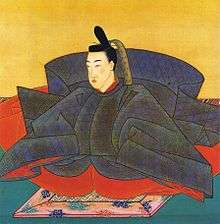Emperor Momozono
| Momozono | |
|---|---|
| Emperor of Japan | |
 Momozono | |
| Reign | 1747–1762 |
| Predecessor | Sakuramachi (father) |
| Successor | Go-Sakuramachi (sister) |
| Born | 14 April 1741 |
| Died | 31 August 1762 (aged 21) |
| Burial | Tsuki no wa no misasagi (Kyoto) |
| Spouse | Ichijō Tomiko |
| Father | Sakuramachi |
| Mother | Anegakōji Sadako |
Emperor Momozono (桃園天皇 Momozono-tennō, 14 April 1741 – 31 August 1762) was the 116th emperor of Japan,[1] according to the traditional order of succession.[2]
Momozono's reign spanned the years from 1747 until his death in 1762.[3]
Genealogy
Before Momozono's ascension to the Chrysanthemum Throne, his personal name (imina) was Toohito (遐仁);[4] and his pre-accession title was initially Yaho-no-miya (八穂宮) and later Sachi-no-miya (茶地宮).
Momozono was the firstborn son of Emperor Sakuramachi. His mother was Lady-in-waiting Sadako (定子) (Empress Dowager Kaimei, 開明門院)
Momozono's Imperial family lived with him in the Dairi of the Heian Palace. This family included at least 2 sons:
- Court lady Ichijō Tomiko (一条富子):
- First son: Prince Hidehito (英仁親) (Emperor Go-Momozono)
- Second son: Imperial Prince Fushimi-no-miya Sadamochi (伏見宮貞行親王)
Events of Momozono's life
During his reign, in 1758, the Hōreki Scandal occurred when a large number of the young court nobility were punished by the Bakufu for advocating the restoration of direct Imperial rule.
- 25 April 1747: Prince Toohito was invested as Crown Prince.[5]
- 9 June 1747: Prince Toohito became emperor.[6]
- 1748 (Kan'en 1): The first performance of the eleven-act puppet play Kanadehon Chushingura (A copybook of the treasury of loyal retainers), depicting the classic story of samurai revenge, the 1702 vendetta of the 47 rōnin.[7]
- 1748 (Kan'en 1): : A Ryukyuan diplomatic mission from Shō Kei of the Ryūkyū Kingdom was received by the shogunate.[8]
- 7 October 1749 (Kan'en 2, 26th day of the 8th month): A terrific storm of wind and rain strikes Kyoto; and the keep of Nijō Castle is burnt after it was struck by lightning.[9]
- 1752 (Hōreki 2): : A Ryukyuan diplomatic mission from Shō Boku of the Ryūkyū Kingdom arrived in Edo.[8]
- 1758 (Hōreki 8): The Hōreki incident involved a small number of kuge who favored a restoration of Imperial power; and this was construed as a threat by the shogunate.[10]
- 1760 (Hōreki 10): Shogun Ieshige resigns and his son, Ieharu, becomes the 10th shogun of the Tokugawa shogunate.[11]
- 1762 (Hōreki 12): The emperor abdicated in favor of his sister.[11]
- 31 August 1762: The emperor died at the age of 21.[6]
Momozono's kami is enshrined in an Imperial mausoleum (misasagi), Tsuki no wa no misasagi, at Sennyū-ji in Higashiyama-ku, Kyoto. Also enshrined here are Momozono's immediate Imperial predecessors since Emperor Go-Mizunoo – Meishō, Go-Kōmyō, Go-Sai, Reigen, Higashiyama, Nakamikado and Sakuramachi, along with five of his immediate Imperial successors – Go-Sakuramachi, Go-Momozono, Kōkaku, Ninkō, and Kōmei.[12]
Kugyō
Kugyō (公卿) is a collective term for the very few most powerful men attached to the court of the Emperor of Japan in pre-Meiji eras. Even during those years in which the court's actual influence outside the palace walls was minimal, the hierarchic organization persisted.
In general, this elite group included only three to four men at a time. These were hereditary courtiers whose experience and background would have brought them to the pinnacle of a life's career. During Momozono's reign, this apex of the Daijō-kan included:
Eras of Momozono's reign
The years of Momozono's reign are more specifically identified by more than one era name or nengō.[13]
See also
Notes

- ↑ Imperial Household Agency (Kunaichō): 桃園天皇 (115)
- ↑ Ponsonby-Fane, Richard. (1959). The Imperial House of Japan, pp. 119–120.
- ↑ Titsingh, Isaac. (1834). Annales des empereurs du japon, pp. 418–419.
- ↑ Ponsonby-Fane, p. 10; Titsingh, p. 418.
- ↑ Meyer, Eva-Maria. (1999). Japans Kaiserhof in der Edo-Zeit, p. 48.
- 1 2 Meyer, p. 48.
- ↑ Hall, John. (1988). The Cambridge History of Japan, p. xxiii.
- 1 2 Titsingh, p. 418.
- ↑ Ponsonby-Fane, R. (1959). Kyoto: the Old Capital of Japan, 794–1869, p. 321; Titsingh, p. 418.
- 1 2 Ponsonby-Fane, Imperial House, p. 119.
- 1 2 Titsingh, p. 419.
- ↑ Ponsonby-Fane, Imperial House, p. 423.
- ↑ Titsingh, p. 418.
References
- Meyer, Eva-Maria. (1999). Japans Kaiserhof in der Edo-Zeit: unter besonderer Berücksichtigung der Jahre 1846 bis 1867. Münster: LIT Verlag. ISBN 978-3-8258-3939-0; OCLC 42041594
- Ponsonby-Fane, Richard Arthur Brabazon. (1959). The Imperial House of Japan. Kyoto: Ponsonby Memorial Society. OCLC 194887
- Screech, Timon. (2006). Secret Memoirs of the Shoguns: Isaac Titsingh and Japan, 1779–1822. London: RoutledgeCurzon. ISBN 978-0-203-09985-8; OCLC 65177072
- Titsingh, Isaac. (1834). Nihon Ōdai Ichiran; ou, Annales des empereurs du Japon. Paris: Royal Asiatic Society, Oriental Translation Fund of Great Britain and Ireland. OCLC 5850691
| Regnal titles | ||
|---|---|---|
| Preceded by Emperor Sakuramachi |
Emperor of Japan: Momozono 1747–1762 |
Succeeded by Empress Go-Sakuramachi |
